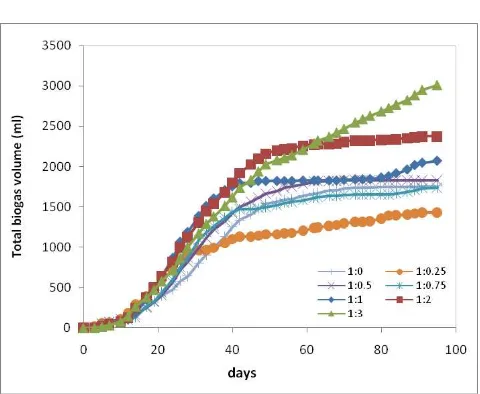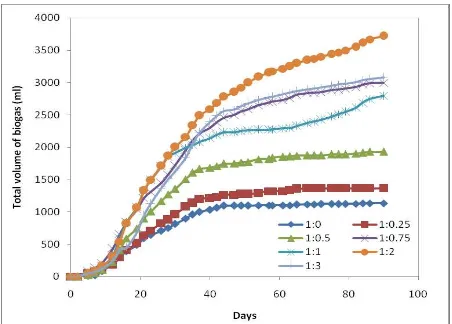Int. Journal of Renewable Energy Development 1 (2) 2012: 61-64
P a g e | 61
Contents list available at IJRED website
Int. Journal of Renewable Energy Development (IJRED)
Journal homepage: www.ijred.com
Biogas Production from Cow Manure
D.A. Putri
a*, R.R. Saputro
b, and Budiyono
baChemical Engineering Department, Faculty of Engineering, Semarang State University, Kampus Sekaran Gunungpati, Semarang, Central Java, Indonesia Postal Code: 50229
bChemical Engineering Department, Faculty of Engineering, Diponegoro University, Jl.Prof Sudharto,SH-Tembalang, Semarang INDONESIA
Article history:
Received April 28, 2012
Received in revised form May 24, 2012 Accepted June 12, 2012
Available online
ABSTRACT: The production of biogas from livestock waste manure in particular is one of the alternative utilization of organic wastes that can be implemented in Indonesia since there is a huge potential of bio-energy in Indonesia. This study utilizes cow manure as the raw material for making biogas and it is coupled with a cow rumen fluid and water. The objective of this study is to determine the effect of manure, rumen, and water composition in biogas production. The research was conducted in anaerobic for 60 days. The composition of manure, water, and the rumen were vary following the variable and ratio; variable A (manure and water); variable B (manure and rumen). The results indicate that the variable A (manure and water) with a 1:3 ratio, and the variable B (manure and rumen) with a 1:2 ratio produced the highest volume of biogas compared to other ratios. The highest biogas production occurred on average at day 23.
Keywords: biogas; cow manure importing countries like Indonesia. In Indonesia, oil and gas are still the main energy source. Continuity in consuming fossil fuel will lead to dwindling of oil reserves. Based on that, renewable energy is needed.
One of the renewable energy sources is biogas. These gases derived from a wide range of organic wastes such as biomass waste, human waste, animal waste through the process of anaerobic digestion and it can be used as energy. Production of biogas from animal manure, especially cow is very potential and has an advantages, energy derived from it is very environmentally friendly since in addition to utilizing the waste from livestock, left over from the process (biogas slurry) can be used as organic fertilizer that is rich in the elements required by plants [1]. The uses of biogas also can reduce atmospheric greenhouse gases and other emissions. The objective of this research was to study the effect of
Citation: Putri DA, Saputro RR, Budiyono (2012)Biogas Production from Cow Manure. Int. Journal of Renewable Energy Development 1(2): 61-64
P a g e | 62
2. Materials and Methods
2.1 Materials
The materials used in this study were cow manure, rumen fluid which taken from RPH Semarang.
2.2 Methods
The cow manure was added into a plastic bottle and mixed with the rumen and or water in accordance with predetermined variables. It is mix briefly until all ingredients are well blended in a bottle. The bottle were covered by rubber that has been hollowed out and given a hose, then clamp the hose clamp using a clip, so in an airtight bottle, and fasten with wire. Then it is stored at temperature of 30°C about 30 days. This study used a wide range of variation in the composition of the mixture (manure and water; manure and rumen), as below:
Table 2
Variation in the composition of the mixture investigated
Run Ratio
Manure Water Rumen
1 1 0 0
2 1 0.25 0
3 1 0.5 0
4 1 0.75 0
5 1 1 0
6 1 2 0
7 1 3 0
8 1 0 0
9 1 0 0.25
10 1 0 0.5
11 1 0 0.75
12 1 0 1
13 1 0 2
14 1 0 3
15 0 0 1
Rumen and water in ml x 100 and the study was conducted in anaerobic for 60 days.
Sample was taken every 2 days for analysis. The process of biogas production carried out for 30 days in order to know the significant differences in biogas generated by each variable.
3. Result and Discussion
3.1. Effect of Water Addition of Biogas Production
The effect of adding water to the production of biogas is analyzed by varying the ratio of manure: water respectively.
The total volume of biogas production in variation of water addition can be shown in Fig. 1. and the effect of water addition in biogas production can be shown in Fig. 2. In general the increase of water addition ratio will increase the production of biogas. In the ratio of manure: water 1:3, the system produce the highest volume of biogas. This phenomena can briefly explained since water addition is nessesary to fulfil the need of -
Fig. 1 Total biogas volume in variation ratio of manure: water during observation
Fig. 2 The effect of water addition ratio in biogas production
Fig. 3 The effect of water addition ratio in daily biogas production
Int. Journal of Renewable Energy Development 1 (2) 2012: 61-64
P a g e | 63
monomers which is insoluble compounds and smaller molecular weights. general the increase biogas production occurred on day 4 to day 24 and at day 25 had peak biogas production and decreased beyond. Variables obtained at 1:1 increase the biogas production drastically, and gas production in this variable is not constant because water levels are not comparable with the levels of manure in the system. On the other hand, the variable 1:3, where there has been a substantial increase but decrease in gas production is also not much, biogas production can be assumed approximately constant. This is due to the ratio of 1:3 has more water content so it is very supporting the process of hydrolysis and acetogenesis. Observation in daily basis stated that the system does not produce the maximum gas but this variable generates a constant gas.
3.2. Effect of Rumen Addition Of Biogas Production
The effect of rumen addition in biogas production is analyzed by varying the ratio of manure: rumen respectively. The result can be shown in Fig. 4 and 5.
The above figure shown that in general, the increase of levels of rumen addition in the system is increasing
Fig. 4 Total biogas volume in variation ratio of manure: rumen during observation
Fig. 5 Total biogas volume in variation ratio of manure: rumen during observation
But at 1:3 ratio, gas production decreased compared with the 1:2 ratio. This observation can be explained as rumen is a source of rumen bacteria (starter) derived from cow's stomach which helps in making the process of anaerobic digestion is biogas. There are posibility in 1:3 ratio, the rumen bacteria was added in huge amount and not fit with the substrate available in the system (limited substrate).
The effect of rumen addition in daily biogas production is analyzed by varying the ratio of manure: rumen respectively. The result can be shown in Fig. 6.
Fig. 6 The effect of rumen addition ratio in daily biogas production
Citation: Putri DA, Saputro RR, Budiyono (2012)Biogas Production from Cow Manure. Int. Journal of Renewable Energy Development 1(2): 61-64
P a g e | 64
4. Conclusion
The results indicate that the variable A (manure and water) 1:3 ratio and the variable B (manure and rumen) with 1:2 ratio produced the highest volume of biogas compared to other ratios. The highest biogas production occurred on average at day 23. Generaly the addition of water and rumen can increase the production of biogas since both raw materials supporting the two important stage in the biogas production (hydrolisis and acetogenesis) in certain level.
References
[1] Ginting N (2007) Penuntun Praktikum Teknologi Pengolahan Limbah Peternakan. Departemen Peternakan, Fakultas Pertanian, Universitas Sumatera Utara.
[2] Khasristya A (2004) Rancang Bangun dan Uji Kinerja Biodigester Plastik Polyethilene Skala Kecil (Studi Kasus Ds. Cidatar Kec. Cisurupan, Kab. garut), Tugas Akhir, Fakultas Pertanian, UNPAD, Indonesia.
[3] Lusk, Philiph D (1998) Methane Recovery from Animal Manures The Current Opportunities Casebook. NREL/SR-580-25145. [4] Metcalf, Eddy (1979) INC. Wastewater Engineering : Treatment
Disposal Reuse, 2nd edition, McGraw-Hill Publishing Company, San
Francisco, California, USA.
[5] Syamsudin TR, Iskandar HH (2005) Bahan Bakar Alternatif Asal Ternak, Sinar Tani, Edisi 21. No. 3129.
[6] Widarto L, Sudarto FX (1997) Teknologi Tepat Guna : Membuat Biogas, Penerbit Kanisius, Yogyakarta.

